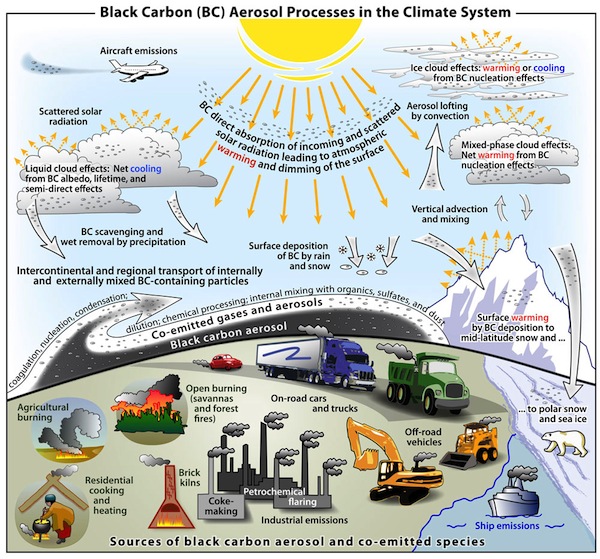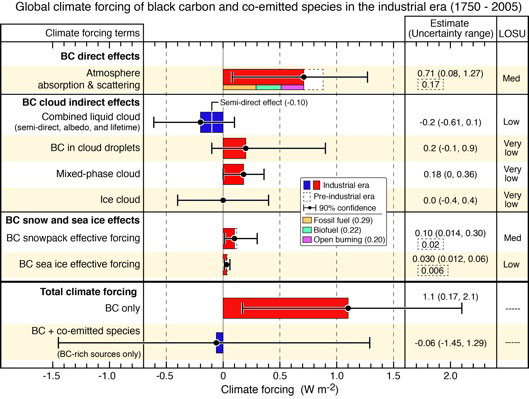Black Carbon Larger Cause Of Climate Change Than Previously Assessed
Black carbon is the second largest man-made contributor to global warming and its influence on climate has been greatly underestimated, according to the first quantitative and comprehensive analysis of this issue.

Figure 1.1 Schematic overview of the primary black carbon emission sources and the processes that control the distribution of black carbon in the atmosphere and determine its role in the climate system.
An International Geosphere-Biosphere Programme news release
Key findings
•Black carbon has a much greater (twice the direct) climate impact than reported in previous assessments.
•Black carbon ranks “as the second most important individual climate-warming agent after carbon dioxide”.
•Cleaning up diesel engines and some wood and coal combustion could slow the warming immediately.
The landmark study published in the Journal of Geophysical Research-Atmospheres today says the direct influence of black carbon, or soot, on warming the climate could be about twice previous estimates. Accounting for all of the ways it can affect climate, black carbon is believed to have a warming effect of about 1.1 Watts per square meter, approximately two thirds of the effect of the largest man made contributor to global warming, carbon dioxide. Co-lead author David Fahey from the U.S. National Oceanic and Atmospheric Administration (NOAA) said, “This study confirms and goes beyond other research that suggested black carbon has a strong warming effect on climate, just ahead of methane.” The study, a four-year, 232-page effort, led by the International Global Atmospheric Chemistry (IGAC) Project, is likely to guide research efforts, climate modeling, and policy for years to come.
The report’s best estimate of direct climate influence by black carbon is about a factor of two higher than most previous work, including the estimates in the last Intergovernmental Panel on Climate Change (IPCC) Assessment released in 2007, which were based on the best available evidence and analysis at that time.
Scientists have spent the years since the last IPCC assessment improving estimates, but the new assessment notes that emissions in some regions are probably higher than estimated. This is consistent with other research that also hinted at significant under-estimates in some regions’ black carbon emissions.
The results indicate that there may be a greater potential to curb warming by reducing black carbon emissions than previously thought. “There are exciting opportunities to cool climate by reducing soot emissions but it is not straightforward. Reducing emissions from diesel engines and domestic wood and coal fires is a no brainer, as there are tandem health and climate benefits. If we did everything we could to reduce these emissions we could buy ourselves up to half a degree less warming–or a couple of decades of respite,” says co-author Professor Piers Forster from the University of Leeds’s School of Earth and Environment.
The international team urges caution because the role of black carbon in climate change is complex. “Black carbon influences climate in many ways, both directly and indirectly, and all of these effects must be considered jointly”, says co-lead author Sarah Doherty of the University of Washington, an expert in snow measurements. The dark particles absorb incoming and scattered heat from the sun (solar radiation); they can promote the formation of clouds that can have either cooling or warming impact; and black carbon can fall on the surface of snow and ice, promoting warming and increasing melting. In addition, many sources of black carbon also emit other particles whose effects counteract black carbon, providing a cooling effect.

Figure 9.1 Quantitative estimates of black carbon climate forcing. This study indicates the direct effects due to black carbon are nearly twice the number reported in the 2007 IPCC Fourth Assessment.
The research team quantified all the complexities of black carbon and the impacts of co-emitted pollutants for different sources, taking into account uncertainties in measurements and calculations. The study suggests mitigation of black carbon emissions for climate benefits must consider all emissions from each source and their complex influences on climate. Based on the analysis, black carbon emission reductions targeting diesel engines followed by some types of wood and coal burning in small household burners would have an immediate cooling impact.
In addition, the report finds black carbon is a significant cause of the rapid warming in the Northern Hemisphere at mid to high latitudes, including the northern United States, Canada, northern Europe and northern Asia. Its impacts can also be felt farther south, inducing changes in rainfall patterns from the Asian Monsoon. This demonstrates that curbing black carbon emissions could have significant impact on reducing regional climate change while having a positive impact on human health.
“Policy makers, like the Climate and Clean Air Coalition, are talking about ways to slow global warming by reducing black carbon emissions. This study shows that this is a viable option for some black carbon sources and since black carbon is short lived, the impacts would be noticed immediately. Mitigating black carbon is good for curbing short-term climate change, but to really solve the long-term climate problem, carbon dioxide emissions must also be reduced,” says co-lead author Tami Bond from the University of Illinois at Urbana-Champaign.

Figure 1.1 Schematic overview of the primary black carbon emission sources and the processes that control the distribution of black carbon in the atmosphere and determine its role in the climate system.
An International Geosphere-Biosphere Programme news release
Key findings
•Black carbon has a much greater (twice the direct) climate impact than reported in previous assessments.
•Black carbon ranks “as the second most important individual climate-warming agent after carbon dioxide”.
•Cleaning up diesel engines and some wood and coal combustion could slow the warming immediately.
The landmark study published in the Journal of Geophysical Research-Atmospheres today says the direct influence of black carbon, or soot, on warming the climate could be about twice previous estimates. Accounting for all of the ways it can affect climate, black carbon is believed to have a warming effect of about 1.1 Watts per square meter, approximately two thirds of the effect of the largest man made contributor to global warming, carbon dioxide. Co-lead author David Fahey from the U.S. National Oceanic and Atmospheric Administration (NOAA) said, “This study confirms and goes beyond other research that suggested black carbon has a strong warming effect on climate, just ahead of methane.” The study, a four-year, 232-page effort, led by the International Global Atmospheric Chemistry (IGAC) Project, is likely to guide research efforts, climate modeling, and policy for years to come.
The report’s best estimate of direct climate influence by black carbon is about a factor of two higher than most previous work, including the estimates in the last Intergovernmental Panel on Climate Change (IPCC) Assessment released in 2007, which were based on the best available evidence and analysis at that time.
Scientists have spent the years since the last IPCC assessment improving estimates, but the new assessment notes that emissions in some regions are probably higher than estimated. This is consistent with other research that also hinted at significant under-estimates in some regions’ black carbon emissions.
The results indicate that there may be a greater potential to curb warming by reducing black carbon emissions than previously thought. “There are exciting opportunities to cool climate by reducing soot emissions but it is not straightforward. Reducing emissions from diesel engines and domestic wood and coal fires is a no brainer, as there are tandem health and climate benefits. If we did everything we could to reduce these emissions we could buy ourselves up to half a degree less warming–or a couple of decades of respite,” says co-author Professor Piers Forster from the University of Leeds’s School of Earth and Environment.
The international team urges caution because the role of black carbon in climate change is complex. “Black carbon influences climate in many ways, both directly and indirectly, and all of these effects must be considered jointly”, says co-lead author Sarah Doherty of the University of Washington, an expert in snow measurements. The dark particles absorb incoming and scattered heat from the sun (solar radiation); they can promote the formation of clouds that can have either cooling or warming impact; and black carbon can fall on the surface of snow and ice, promoting warming and increasing melting. In addition, many sources of black carbon also emit other particles whose effects counteract black carbon, providing a cooling effect.

Figure 9.1 Quantitative estimates of black carbon climate forcing. This study indicates the direct effects due to black carbon are nearly twice the number reported in the 2007 IPCC Fourth Assessment.
The research team quantified all the complexities of black carbon and the impacts of co-emitted pollutants for different sources, taking into account uncertainties in measurements and calculations. The study suggests mitigation of black carbon emissions for climate benefits must consider all emissions from each source and their complex influences on climate. Based on the analysis, black carbon emission reductions targeting diesel engines followed by some types of wood and coal burning in small household burners would have an immediate cooling impact.
In addition, the report finds black carbon is a significant cause of the rapid warming in the Northern Hemisphere at mid to high latitudes, including the northern United States, Canada, northern Europe and northern Asia. Its impacts can also be felt farther south, inducing changes in rainfall patterns from the Asian Monsoon. This demonstrates that curbing black carbon emissions could have significant impact on reducing regional climate change while having a positive impact on human health.
“Policy makers, like the Climate and Clean Air Coalition, are talking about ways to slow global warming by reducing black carbon emissions. This study shows that this is a viable option for some black carbon sources and since black carbon is short lived, the impacts would be noticed immediately. Mitigating black carbon is good for curbing short-term climate change, but to really solve the long-term climate problem, carbon dioxide emissions must also be reduced,” says co-lead author Tami Bond from the University of Illinois at Urbana-Champaign.
You can return to the main Market News page, or press the Back button on your browser.

